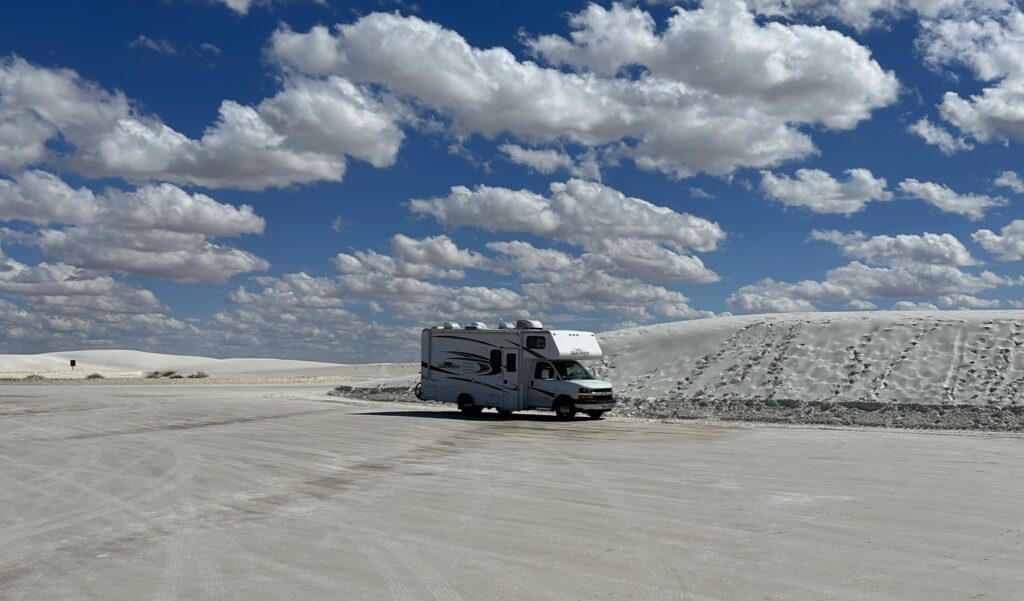Profitable RV Life: Smart Ownership That Pays You Back
Ever dreamed of hitting the open road in your own home on wheels? Maybe you’ve scrolled endlessly through #vanlife posts on Instagram, wondering if RV or van life could be right for you (guilty as charged! 🙋♀️). I’m sharing our complete journey from RV dreamers to owners, including how we’re turning our investment into an income-generating asset. Let’s dive into everything you need to know!
Dreams vs. Reality
For years, we had this vision: a cute little teardrop trailer, the open road, and the freedom to work remotely while exploring different states for several months. You know the kind of dream I’m talking about – the one that starts as a “wouldn’t it be nice,” and slowly transforms into endless hours of YouTube videos and Instagram reels.
But here’s the thing about dreams – sometimes they need a reality check. Our first wake-up call came at a camper dealership, where we realized our current SUVs couldn’t handle towing even the smallest trailer. Plus, with our two medium-sized dogs, that cozy teardrop started looking more cramped than cute. We left feeling pretty discouraged, especially with our wedding on the horizon and budget concerns looming.
We simply couldn’t afford a new vehicle AND a camper so we kind of gave up on the idea for a while. Except I couldn’t stop quietly fantasizing about trying out van life or RV life. I really really thought this could be something we’d truly love.
When the Math Started Making Sense
Fast forward a few months – one night my now husband, Ryan, said he had a gift for me. I was pretty confused because he didn’t bring anything with him that evening? Plus why would he be giving me a gift? We were about to have our wedding, and we never, ever exchange gifts – not for birthdays, holidays, anything. It’s just something we decided on early in our relationship.
He proceeded to tell me his idea of buying a camper van or motorhome, and renting it out when we weren’t using it. I hadn’t even fathomed the idea of buying a camper van or motorhome, as I had this preconceived notion that anything decent would be close to $100k… But I became obsessed with this idea, and the part about renting it out had never even crossed my mind.
A drivable RV or van would have been much better for us space-wise with our two dogs than a teardrop camper or trailer, plus it would be a lot easier to rent out as opposed to a trailer that also needs a tow vehicle.

Finding Our Perfect Match
After months of research (and yes, countless more hours of YouTube videos), we landed on something completely different from our original plan: a 24-foot Class C motorhome. Why? First, Class C motorhomes are surprisingly affordable compared to those Instagram-worthy converted vans. We’re talking about half the price in many cases! Plus, they come ready to roll – no need to spend months creating a DIY build-out.
We spent some time online looking at local RV dealers’ websites, Craigslist, and Facebook Marketplace. I had assumed we would need to go through a dealer to finance something. But here’s the real kicker that most people don’t realize: financing an RV is totally possible for private sales. I always thought buying from a private seller meant needing a huge stack of cash, but nope! Banks and credit unions actually offer loans for used RVs, often with pretty reasonable rates.
Our search led us to a 2014 Forest River Sunseeker with just 35,000 miles – a real gem in the used RV market. But let me tell you about the emotional rollercoaster of actually buying it. You know that mix of excitement and terror when you make a big life decision? Multiply that by about a thousand. Wait – why are we doing this again? Besides our house, this was the largest purchase we had ever made.
Our seller was super patient with us and we finalized the sale at the bank with the seller before he handed over the keys. They even did an early state inspection and some maintenance before the sale. Pro tip: when you find a seller who’s this thorough, it’s usually a good sign they’ve taken great care of the RV.
The Learning Curve
Remember how I mentioned YouTube videos? Well, we basically earned a PhD in RV Studies from YouTube University. From backing up techniques to dump station etiquette (yes, that’s a thing), we absorbed everything we could before our first camping trip.
And speaking of first trips, we didn’t actually finalize the purchase until late October 2023. We picked literally the last possible weekend any campground was open in our area for a test run. Talk about pressure! But you know what? Sometimes jumping in with both feet is the best way to learn. We managed to drive it, back it into a campsite, level it, and hook everything up successfully. Pop the champagne!

The Business Side: Making Your RV Work for You
The whole reason we went the Class C motorhome route was so that we could rent it out when we weren’t using it. Besides a month-long cross country trip plus several weekends of local camping, we couldn’t be using it all the time alongside working at our jobs. RV ownership doesn’t have to be an either/or proposition between enjoying it yourself and making it financially viable. You can actually do both!
So, let’s talk about the part that makes this whole adventure financially feasible: turning your RV into an income-generating asset. After over a year of renting, here’s (some of) what we’ve learned:
- It’s a lot of work. Between managing guest communications, calendars on multiple platforms, and cleaning/ prep in between rentals, it’s certainly a challenging but worthwhile side hustle.
- The listing is everything. I spent hours and hours learning how to craft a great listing. High-quality, well-lit photos are very important, as well as having a super detailed and enticing listing description.
- Location, location, location. We are lucky that we live in Vacationland (aka Maine). The RV rental market is hot in southern Maine due to proximity to Acadia National Park, tons of State Parks, beaches, and mountains.
- Don’t take things personal. Things WILL go wrong. It’s not your fault. Things break in RVs, and as long as you’ve done the preventative maintenance that you should be doing anyways, when things go wrong when your RV is out on rental, you just have to roll with the punches.
- Price in the low range when just starting out. Do your research to see what similar rigs are renting for in your area. Then, price on the lower side so you can get eyeballs on your listing and start making bookings and therefore collecting reviews, which will increase your chances of getting seen in search.
- List on all the platforms. There are three main RV rental platforms – Outdoorsy, RVshare, and RVezy. Listing on all three will increase your chances of being seen in the marketplace.
- Keep your calendar up to date. The key is finding the sweet spot between making your RV available for renters while still enjoying it yourself. Also be sure to consider time for cleaning and other prep/maintenance in between rentals. I like allowing 48 hours in between rentals.
- Over communicate and be patient. Guests might have a lot of questions, as many people have never driven or stayed in an RV before. The next two bullets will help with this too!
- Create a how-to manual for guests. Having an extremely detailed how-to manual that you send your guests in advance of their trip and that’s printed in a binder will be your saving grace from those late night questions or phone calls.
- Create how-to videos for your hookups. If you want to go even a step further, how-to videos will be so appreciated by your newbie guests and will further reduce questions during their trip.
Real Numbers That Matter
Let’s get transparent about the finances (because I wish more people would):
Purchase price: $35,000 (with $8,000 down and $27,000 financed)
Monthly payment: $561 (5-year loan)
First year rental revenue: $9,887
Maintenance and other miscellaneous costs during the first year: $4,138
Profit from renting after maintenance costs: $5,748
After about a year and a half of ownership, we’re actually several months ahead of our payment schedule because after maintenance costs, all our profit has gone straight toward paying off the loan!
I will also preface this all by saying we have been lucky to not have any serious costs with our RV since owning it.
And in terms of insurance, while we of course have our own policy on the rig, there is a gap in coverage while renters are using the RV. This is covered by the rental platform in the event of an accident. Renters are required to purchase an insurance policy while booking which covers the RV exterior, and a security deposit covers potential interior damage.
What I Wish I’d Known
Looking back, here are the insights that would have made our journey smoother and probably happen a few years sooner:
- The RV market is way more flexible than you might think. From financing options to rental possibilities, there are creative ways to make it work for your budget.
- Don’t get too attached to your first idea. Our perfect match was completely different from what we initially imagined.
- Take time to learn the systems before your first trip, but don’t let perfectionism or fear keep you from getting started.

Your Turn to Hit the Road
If you’re sitting there with an RV-shaped dream in your heart (and maybe an Instagram feed full of inspiration), here’s my advice: start researching, but stay flexible. Your perfect RV might be completely different from what you initially imagine, and that’s okay!
Remember, the goal isn’t just to own an RV – it’s to create a lifestyle that works for you, whether that means weekend getaways, extended road trips, or building a rental business that helps pay for your adventures.
Want to know more about specific aspects of our journey or have questions about starting your own RV adventure? Follow @sandmanntravels on socials (Instagram, Facebook, Threads, Pinterest) or get in touch. I’d love to help you avoid some of the learning curves we faced!
Happy camping (and maybe even happy earning)!

